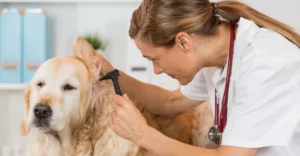Ever caught your furry friend scratching more than a DJ at a paw-ty? It might be more than just a pesky itch; your pup could be dealing with a skin infection. Understanding canine dermatological health is crucial, whether you’re a seasoned dog owner or a first-time puppy parent. In this comprehensive guide, we’ll explore the causes, symptoms, and effective treatments for skin infections in dogs.
We’re on an odyssey to empower you with the knowledge to identify, address, and prevent skin issues. Let’s delve into some doggy dermatology and together, we’ll unravel the mysteries behind your pup’s scratching habits, and discover the keys to a happy, healthy, and itch-free life for your beloved companion.
Exploring the intricate world of dog skin health and gaining insights will make you the best advocate for your four-legged friend. Whether you’ve observed subtle changes or your dog’s scratching has become a persistent concern, this guide is your go-to resource. Stay tuned for a paw-spective journey through the realm of canine dermatology, where each wag, scratch, and bark tells a unique story waiting to be uncovered.
Let’s start from the basics; your dog’s skin. A marvel of biological engineering, it is more than just a cover – it’s the superhero cape that shields against the elements. Picture it as the largest organ, with a crucial role in protecting against germs, controlling body temperature, and hosting hair roots that contribute to that furry coat we all love and adore.
Now, let’s break down the science:
- Follicles: Think of these as tiny hair homes. Each follicle is like a cosy abode for hair growth, determining the thickness and colour of your dog’s fur.
- Sebaceous Glands: These are like natural moisturizers. Sebaceous glands produce oils that keep your puppy’s skin hydrated and their coat glossy – basically, the skin’s way of saying, “I got this!”
- Sensory Receptors: Consider these as your dog’s built-in antennae or sensors. They detect sensations like touch and temperature, helping your furry friend navigate the world through their skin.
Ever wondered about this intricate coat? It’s not just for show. Hair growth, influenced by genes and hormones, follows a cycle involving growth, rest, and shedding. Different breeds have different shedding patterns. Understanding these shedding patterns helps identify if something is amiss in your dog’s skin health.
As we navigate the landscape of your canine companion’s skin, envision it as a dynamic ecosystem – a habitat of tiny homes, natural moisturizers, and built-in sensors. The skin caters to multiple functions working like a well-oiled machine. But when something is amiss, there is chaos.
Common symptoms of skin infections in dogs
Now that we’ve unveiled the potential culprits in your dog’s skin drama, it’s time to play detective. How does your pup drop hints when something’s amiss with their skin? Recognizing these signs is vital to early intervention.
Excessive scratching is like your dog’s way of signalling distress. It could be a response to itching caused by infections or irritants. Pay attention when your pup turns into a scratching maestro – it might be a subtle SOS.
1. Look for signs of inflammation
Redness on your dog’s skin is akin to a warning sign. It signifies inflammation, often a response to infections or allergies. If you notice areas turning redder than usual, it’s time to investigate.
2. Pustules and Bumps: Microbial Warfare Marks
If your pup’s skin resembles a bumpy landscape, it’s time to take notice. Pustules are small, pus-filled bumps, that can indicate bacterial infections like Pyoderma. Imagine them as tiny battle scars on your dog’s skin from the ongoing microbial warfare.
3. Sudden Hair Loss
A sudden change in your dog’s coat, with patches of hair loss, might be more than just a bad hair day. It could be a consequence of parasites or skin infections in your dog. Keep an eye out for any unplanned fur departures outside of your dog’s shedding pattern.
4. Unsettled Ears are a sign of distress
If your dog is shaking their head or scratching their ears more than usual, it’s a sign that something’s not right. Ear infections, often linked to allergies or parasites, can be a source of discomfort for your furry friend.
While ear infections can be localized in the ears, it has broader implications for the overall skin condition of your pet. The discomfort caused by these skin infections may extend beyond the ears, highlighting the interconnected nature of dermatological health. Recognizing these subtle distress signals in your dog’s ears is crucial for early detection and intervention in the realm of canine dermatology.
As we traverse the intricacies of canine skin, let’s meet the main suspects behind those unmistakable signs. Understanding these potential troublemakers is essential for targeted intervention.
What causes skin infection in dogs?
1. Flea and Ticks
Imagine fleas and ticks as the gatecrashers at the skin party. These minuscule parasites irritate and open the door to a myriad of skin infections. Did you know that a single flea can lay up to 50 eggs per day? Regular preventive measures, such as flea and tick treatments, are your best defence.
Here is more information on how to get rid of ticks.
2. Hidden Allergy
Allergies, the silent saboteurs, can lead to itching, redness, and inflammation. Did you know that certain dog breeds, like Retrievers and Terriers, are more predisposed to allergies? Identifying and eliminating triggers, be it seasonal pollen or specific foods, is crucial for managing allergic reactions.
For example, atopic dermatitis (eczema), a condition identified by dry, itchy and inflamed skin, is often triggered by environmental allergens like pollen, mould, or dust mites. Food allergies can manifest as skin problems, demanding a specialized diet under veterinary guidance. Flea allergy dermatitis results from sensitivities to flea bites, necessitating rigorous flea control measures. Contact dermatitis may arise from substances like plants or cleaning products, causing redness and itching upon contact. Inhalant allergies, similar to atopic dermatitis, involve reactions to airborne particles.
3. Mites and Mange Mayhem: Microscopic Trouble
Mites, microscopic troublemakers, can lead to conditions like mange. Resulting in hair loss and intense itching, mange requires prompt attention. Did you know that Sarcoptic mange, caused by Sarcoptes scabies, is highly contagious among dogs? Think of it as an unwelcome houseguest that needs eviction, ASAP.
4. Hormonal Imbalance
Hormonal imbalances, often linked to conditions like Hypothyroidism or Cushing’s disease, can impact your dog’s skin. Did you know that hormonal imbalances can alter the production of essential skin oils, leading to dryness or excessive oiliness? Keep an eye out for changes in coat texture, thickness, or overall skin condition.
By identifying these common culprits with additional facts and statistics, you gain the knowledge to tackle the root cause, not mere symptoms.
What to do if you see these signs of skin infection in your dog?
1. Immediate Care
- Prevent Licking or Scratching: Use an Elizabethan collar or protective dressing to prevent further irritation.
- Gentle Cleaning: Clean the affected area with a mild, pet-safe antiseptic solution or wipes.
- Avoid Home Remedies: Refrain from applying over-the-counter creams or ointments without veterinary guidance.
2. Consult a vet
If the infection seems to be spreading quickly, or if there are signs of lethargy, fever or lack of appetite, you must immediately seek medical help.
During a vet visit, they’ll examine your dog’s skin, possibly conduct tests, and gather essential clues to pinpoint the root cause. It’s like a thorough forensic analysis but for your furry friend. Your vet may employ various tools, from skin scrapings to blood tests, to unravel the specifics of the skin condition. Advanced diagnostic techniques, such as cytology and histopathology, offer detailed insights.
Once the culprit is identified, your vet will prescribe a tailored treatment plan. Whether it’s medications, special shampoos, or dietary adjustments, think of it as a personalized roadmap to nurse your pup’s skin back to health. Regularly check the affected area for signs of improvement or worsening.
Remember, early detection and professional guidance are crucial for effective intervention. Now, let’s explore the array of treatment options available.
3. Emotionally supporting your pet is crucial
A dog’s emotional well-being significantly influences their overall health, including skin condition. Stress and anxiety can manifest in various ways, including impacting skin health through behaviours like excessive scratching, licking, or changes in coat texture.
Dogs thrive on routine and predictability. Establishing a consistent schedule for feeding, walks, and playtime provides a sense of security. Changes in routine, new environments, or even the introduction of a new pet can trigger interim stress. Pay attention to behavioural cues such as restlessness, pacing, or withdrawal. Uncharacteristic aggression can also be indicative of stress.
Regular exercise not only keeps your dog physically fit but also releases endorphins, reducing stress and promoting mental balance. Engage in activities that align with your dog’s breed and energy levels.
Provide your dog with a designated safe space where they can retreat when feeling overwhelmed. This might be an expansive lawn, a balcony with an open view, a snug bed tucked away in a peaceful nook, or a comfortable crate. A happy, well-adjusted pupper is less likely to exhibit behaviours that can lead to skin infections in dogs.
Preventative measures to avoid skin infections in dogs
1. Strategic Grooming Practices
Grooming is pivotal in maintaining your dog’s skin health. Choose tools appropriate for their breed, ensuring regular brushing to remove loose fur and debris. This keeps their coat in prime condition and stimulates natural oil production for skin resilience.
2. Nutritional Foundations
A dog’s diet profoundly impacts skin health. Ensure their food meets specific nutritional needs, with emphasis on omega-3 fatty acids, zinc, and vitamins A and E— those critical for skin integrity and a lustrous coat.
Nutritionally, omega-3 fatty acids from fish oil contribute to an anti-inflammatory response, reducing the risk of allergic reactions affecting the skin. Zinc supports skin cell regeneration, while vitamins A and E act as antioxidants, protecting against environmental damage.
3. Hygiene Protocols
Ensuring meticulous environmental hygiene is paramount for your dog’s well-being. Make it a routine to regularly wash your furry friend’s bedding, effectively eliminating potential allergens. Additionally, thoroughly vacuuming the areas your dog frequents helps reduce their exposure to environmental triggers, further safeguarding against skin irritations. This commitment to cleanliness not only lowers the likelihood of infections but also plays a pivotal role in controlling microbial populations, thereby minimizing the risk of various conditions arising from bacterial or fungal overgrowth.
4. Chemical Consciousness
Choose grooming products designed for canine skin to maintain its natural balance. Harsh chemicals can disrupt the skin barrier and oil balance, leading to irritation. Opt for pH-balanced formulations to support skin health.
Conscious product choices, aligned with your dog’s unique skin needs, contribute to a harmonious skin environment. Prioritize pH-balanced formulations and consult your vet for tailored product recommendations.
Check out a few favourite Organic and Natural pet product Brands in India.
5. Environmental Vigilance
Understand your dog’s environmental sensitivities. Provide shade during hot weather and protect them from harsh conditions in colder climates. Limit exposure to potential irritants like pollen and pollutants. Consult ingredient list on dog food and treat labels for potential allergen warnings. Examine the ingredient list on dog food and treat labels for potential allergen warnings.
6. Routine Vet Assessments
Regular vet check-ups are crucial for proactive skin care. Early detection of underlying issues enables tailored preventive strategies. Your vet may recommend supplements or treatments based on your dog’s unique needs. Always refrain from self-diagnosing when it comes to identifying skin infections in your dog.
And here is a handy list of vet clinics in Bangalore, Delhi, Noida, Mumbai, Hyderabad,
7. Dog Training and Skin Health
Well-trained dogs often exhibit fewer stress-related behaviours, positively impacting skin health. Training contributes to a harmonious living environment, reducing the likelihood of excessive scratching or licking that could lead to skin issues.
If you are considering experienced professionals to train your dog, take a look at our comprehensive guide on How to Find the Right Pet Trainer.
In conclusion, a comprehensive approach to home care is an investment in your dog’s well-being. By integrating these practices, you actively contribute to the longevity and vibrancy of your canine companion’s skin health.
Delving into the emotional facets of your dog’s life becomes more than a health strategy—it’s the heartbeat of a fulfilling companionship. By unravelling and tending to these emotional layers, you not only nurture skin well-being but also foster a profound sense of joy and contentment in your canine companion. Creating a haven of support and understanding, you become the architect of a happier, more contented life for your four-legged friend. After all, the healthiest glow on your dog’s skin mirrors the radiance of a well-loved, emotionally enriched life.























